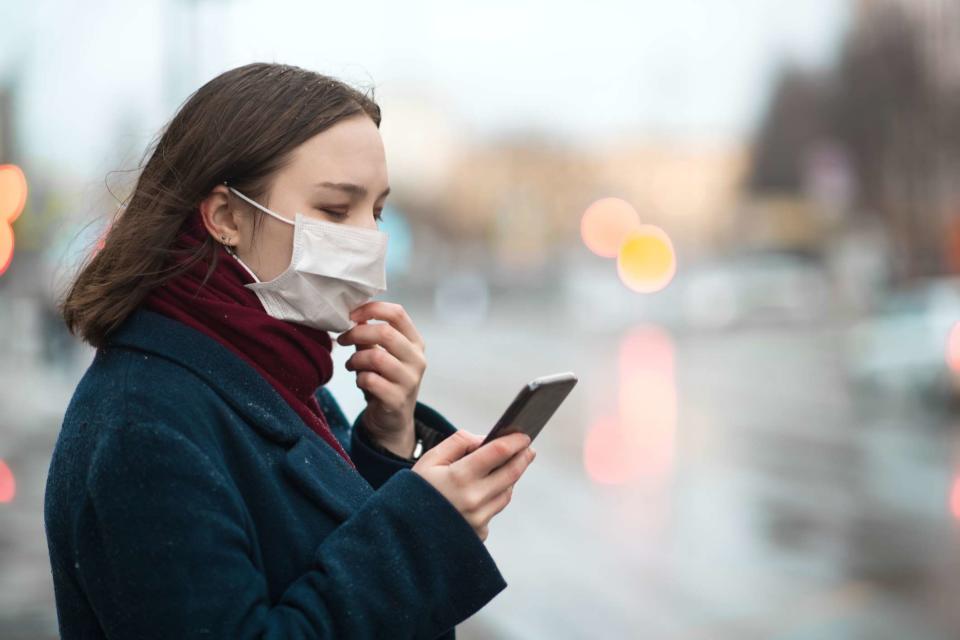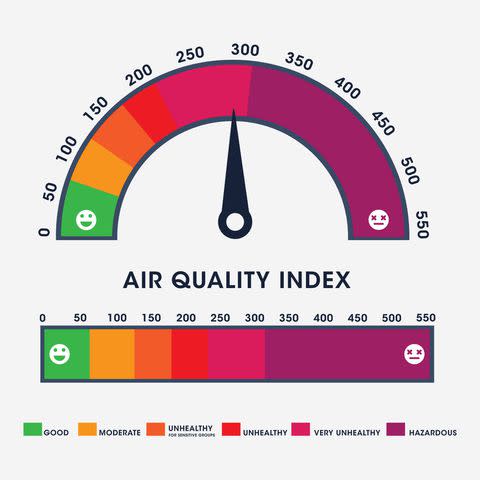What Does 'Unhealthy Air Quality for Sensitive Groups' Mean?
Everything you need to know about that alert on your weather app.

Fact checked by Elizabeth MacLennan
Seeing the words “unhealthy air quality for sensitive groups” when checking your weather app can be jarring, but this small piece of information can actually be life-saving. This is an air quality alert that refers to “code orange” days, or days when the air outside your door has reached pollution levels that might be hazardous for children, the elderly, and those with pre-existing health conditions.
What Causes Unhealthy Air Quality?

Alkimson / Getty Images
Specs of tree pollen float in the air.Unhealthy air can originate from a number of sources, such as emissions from nearby factories and fossil-fuel-based power plants, wildfires, and seasonal pollen. Even weather can affect air quality. For example, high pressure systems, which are associated with sinking air, encourage pollutants to accumulate near earth’s surface where they’re breathed in at a higher rate. During winter, thermal inversions (cold air near the surface and warmer air aloft) have a similar effect since colder, denser air can trap pollution at ground levels. And as evidenced in June 2020 when dust from Africa’s Sahara Desert was whisked nearly 5,000 miles away to the U.S. Gulf of Mexico, winds can play a part in spreading pollution over long distances.
Who Is Included in "Sensitive Groups"?
Breathing polluted air isn’t healthy for anyone, but for some individuals—including children, seniors, adults who are active outdoors (such as manual laborers), and people with heart disease, lung disease (such as asthma, emphysema, and bronchitis), or diabetes—doing so can be especially harmful.
People with respiratory illness, for example, may struggle to breathe as deeply as normal, and could experience coughing, wheezing, shortness of breath, and fatigue as a result of particle pollution that triggers inflammation of their airways and lungs.
Children are at increased risk from air pollution primarily because they spend prolonged periods of time outdoors. What’s more, much of this time is spent playing sports or games, meaning children are not only exposed to unhealthy air for longer periods of time than adults, but also at higher rates. (The more strenuous the activity, the more air intake is required, thus the more unhealthy air that is breathed in.) Since kids’ lungs are still developing, high levels of pollutant exposure can go so far as to cause irreversible damage, including decreased lung-function growth. The fact that about 1 in 14 children (7%) have asthma also puts youth at increased risk.
Older adults (those 65-years-old and up) are not only more susceptible to environmental hazards because they’re more likely to have a pre-existing condition, but also because the aging process makes their bodies less resilient to external stressors.
The link between air pollution and heart disease is more subtle. Extremely small pollution particles known as PM2.5 are the most hazardous to those with cardiovascular disease because they can pass into the bloodstream, irritating blood vessels. This in turn can cause blood vessels to rupture, triggering a heart attack or stroke.
As for the link between air pollution and diabetes, medical studies show that pollutants can impair glucose metabolism and insulin resistance. Those who have or are at risk of developing type 2 diabetes should take extra care to limit exposure when the dominant daily AQI pollutant falls under that category.
Healthy adults who don’t identify with any of the above groups but who spend significant amounts of time outdoors are also included in the sensitive groups category, since their routine activities result in higher exposure rates than someone who spends the occasional hour outdoors.
The Air Quality Index
For many, air quality alerts such as “unhealthy for sensitive groups” is their introduction to the fact that air quality forecasts even exist. Just as the National Weather Service (NWS) is responsible for monitoring weather conditions and hazards across the United States, the U.S. Environmental Protection Agency (EPA) monitors and reports on air quality each day. It also issues air quality forecasts for up to six days ahead. The EPA does this via the Air Quality Index (AQI).
What Is the Air Quality Index?
The AQI is a nationwide tool for communicating daily air quality. Created under the Clean Air Act, it uses color-coded categories to tell the public how clean or polluted their local air is. It also details which groups of people may be affected, and suggests steps individuals can take to avoid health effects associated with poor air quality.
AQI values, which range from 0 to 500, are calculated using pollutant concentration data. If multiple pollutants are present on any given day, that day’s AQI is based on whichever single pollutant poses the highest threat.
As a rule of thumb, AQI values below 100 are considered satisfactory, whereas values above 100 signal unhealthy air quality.
Major Air Pollutants Measured by AQI
Five major pollutants are measured by the AQI: ground-level ozone, carbon monoxide, sulfur dioxide, nitrogen dioxide, and two types of particle pollution (inhalable solid and liquid specs, which are smaller in size than the diameter of a human hair).
While other kinds of pollution exist, only these five are reported by the AQI. Lead (Pb) is another common air pollutant that's regulated under the Clean Air Act; however, it isn’t included in the AQI because it takes weeks to collect and analyze lead samples. What’s more, the removal of lead from gasoline (as in leaded vs. unleaded gas) resulted in a 98% decrease in lead emissions between 1980 and 2014. As a result of this, lead isn’t currently considered as a major pollutant.
Ozone (O3)
Ozone is one of the most common pollutants found in the United States. It’s also the primary source of smog. When it lives roughly six miles above the surface in Earth’s stratosphere, it protects life on earth from the sun’s harmful ultraviolet radiation. However, when ozone exists at ground levels where it can be breathed in, it’s considered harmful to human health and can trigger asthma attacks or even cause asthma to develop. Unlike other pollutants, ozone isn’t emitted directly into the air; it’s created when nitrogen oxides (NOx) and volatile organic compounds (VOCs), such as those from vehicle exhaust, chemically react in the presence of heat and sunlight.
Carbon Monoxide (CO)
Carbon monoxide is a colorless, odorless gas that’s released through burning. (Kerosene heaters and gas stoves are two well-known sources of indoor carbon monoxide.) Carbon monoxide can lower the amount of oxygen that can be carried in the bloodstream to vital organs like the heart and brain. As a result, exposure to high levels of it can cause dizziness, unconsciousness, and even death.
Sulfur Dioxide (SO2)
The largest source of sulfur dioxide gas in the atmosphere is the burning of fossil fuels by power plants and other industrial facilities. Asthma sufferers are particularly sensitive to it. Alongside nitrogen oxide, it plays a significant role in forming acid rain.
Nitrogen Dioxide (NO2)
Nitrogen dioxide is a gas that primarily enters the air from the burning of fuel, which is why its primary sources include vehicle emissions, fossil-fuel-based power plants, and commercial manufacturing. When breathed in, it irritates the body’s airways and can aggravate or even cause respiratory disease. When nitrogen dioxide reacts with sulfur dioxide and water molecules in the atmosphere, it forms acid rain.
Particulate Matter (PM10)
Particulate matter refers to a group of solid particles and liquid droplets that can remain airborne. Particles that are large enough to be seen floating in the air, yet are small enough to be inhaled, make up a group of pollutants known as PM10. They include dust, soot, pollen, mold, and other specs having diameters of around 10 micrometers. (To help put that into perspective, consider that the average human hair has a diameter of 70 micrometers.)
Particulate Matter (PM2.5)
The smallest types of particulate matter, called “fine” particulates or PM2.5, measure less than 2.5 micrometers across and are too tiny to see with the naked eye. They’re so microscopic, in fact, that once they’re inhaled, they can pass into the bloodstream. As a result, they pose the greatest risk to health, especially to those with cardiovascular disease. Smoke is a primary source of fine particulates.
Six Categories of Air Quality

Danijelala / Getty Images
Air Quality Index infographic.To make it easier for people to determine how pristine or polluted their local air quality is, the AQI is divided into six color-coded alert categories. The “warmer” the alert color, the more hazardous the air quality. Each category also corresponds to a range of AQI values, with higher values pointing to greater levels of air pollution and greater health dangers.
Good (Green)
A green level (AQI values up to 50) signifies good air quality. These are the best days to be active outdoors, since air pollution poses little to no risk.
Moderate (Yellow)
A yellow level (AQI values of 51-100) means that air quality is OK for the general public. Sensitive groups, however, may face an elevated health risk and should take caution while outdoors.
Unhealthy for Sensitive Groups (Orange)
Under an orange level (AQI values of 101-150), sensitive populations may experience health effects; as a result, they should reduce the amount of time spent outdoors. The general public is less likely to be affected.
Unhealthy (Red)
A “code red” air quality day (AQI values of 151-200) is considered unhealthy for everyone. It’s advised that the general public reduce time spent outdoors, as some individuals’ health may be impacted. Sensitive groups may experience more serious health effects, and should avoid spending prolonged periods of time outdoors.
Very Unhealthy (Purple)
A purple level (AQI values of 201-300) is considered very unhealthy for everyone. The general public should avoid spending prolonged periods of time outdoors, while sensitive groups should avoid going outdoors altogether.
Hazardous (Maroon)
A maroon level (AQI values of 301-500) is considered extremely hazardous for everyone. When this type of air quality alert is issued, all groups should avoid going outdoors.
How Effective Are Air Quality Alerts?
According to a 2020 study in the journal Risk Analysis, air quality alerts lower mortality rates by four to 290 deaths per million people. However, air quality alerts can only be effective if they’re widely available to the public and well understood.
According to the EPA, only metro areas with populations of 350,000 or more are required to report the daily AQI, meaning those who live in smaller towns might not automatically receive air quality data. In this case, knowing where to access your local air quality forecast—at Airnow.gov and the NWS Air Quality Forecast Guidance website—is key. Those who prefer to receive air quality alerts via email or text can also sign up for free air quality notifications through the EPA-sponsored EnviroFlash program.
In addition to these resources, the EPA, NWS, Centers for Disease Control and Prevention, and the U.S. Forest Service co-host an annual air quality awareness week every May in an effort to raise air quality awareness among the general public.
What to Do When the Air Quality Is Unhealthy
When the air quality is unhealthy, the best way to reduce exposure to particle pollution is to reduce time spent outdoors or avoid going outdoors altogether.
The following tips can help limit your pollutant exposure even further.
Keep your vehicle’s ventilation setting on “recirculate,” especially when driving on busy roads.
If you need to refuel your vehicle, wait until after dark to pump gas. It'll discourage additional gas emissions from mixing with sunlight and heat to create ground-level ozone.
Avoid using gas-powered lawn mowers.
Don't burn leaves, garbage, or use wood stoves or fireplaces; doing so will contribute to the elevated air pollution levels in your area.
Reduce the intensity of any outdoor activities; the more strenuous the activity, the more air intake you’ll require, and the more unhealthy air you’ll breathe in.
Keep prescribed medications on hand in case any symptoms are triggered.
Keep your home’s windows and doors closed.
Use High Efficiency Particulate Air (HEPA) filters and air purifiers in your home; they help keep indoor particle levels low by trapping over 99% of pollutants 0.3 microns in size.
Wear a mask/respirator that’s capable of filtering very small particles.
Drink plenty of fluids to keep respiratory membranes moist, which in turn helps reduce the inflammatory response.
And above all else, don’t forget to keep an eye on the AQI.

